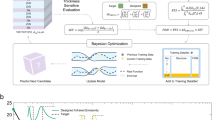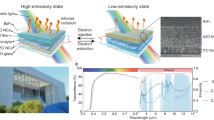Abstract
A visible transparent metamaterial absorber was designed and fabricated with ultrabroadband microwave absorption and low infrared emissivity to meet the increasing demand for multispectral compatible camouflage. The absorber was fabricated with a low-infrared emissive layer at the top, a microwave-absorbing layer in the middle, and a reflective layer at the bottom, which were separated by polymethyl methacrylate plates. The absorber showed an average visible transmittance of 55%, infrared emissivity of ∼0.37, and effective microwave absorption bandwidth of 32.1 GHz with a total thickness of 3.0 mm. Furthermore, microwave absorption exhibited wide-angle stability and polarization insensitivity characteristics. The mechanism of microwave attenuation was further explored through effective electromagnetic parameters as well as surface current, electric field, magnetic field, and energy loss density distributions. The experimental results were consistent with those of the simulations and calculations, indicating the potential of the designed metamaterial absorber for future applications in multispectral compatible camouflage.
Similar content being viewed by others
References
Li D, Chen Q, Huang J, et al. Scalable-manufactured metamaterials for simultaneous visible transmission, infrared reflection, and microwave absorption. ACS Appl Mater Interfaces, 2022, 14: 33933–33943
Feng X, Pu M, Zhang F, et al. Large-area low-cost multiscale-hierarchical metasurfaces for multispectral compatible camouflage of dual-band lasers, infrared and microwave. Adv Funct Mater, 2022, 32: 2205547
Shrestha S, Wang Y, Overvig A C, et al. Indium tin oxide broadband metasurface absorber. ACS Photonics, 2018, 5: 3526–3533
Chen W, Zhan J, Zhou Y, et al. Microwave metamaterial absorbers with controllable luminescence features. ACS Appl Mater Interfaces, 2021, 13: 54497–54502
Du Z, Liang J, Cai T, et al. Designing an ultra-thin and wideband low-frequency absorber based on lumped resistance. Opt Express, 2022, 30: 914–925
Sheokand H, Singh G, Ghosh S, et al. An optically transparent broadband microwave absorber using interdigital capacitance. Antennas Wirel Propag Lett, 2019, 18: 113–117
Xu C, Wang B, Yan M, et al. An optical-transparent metamaterial for high-efficiency microwave absorption and low infrared emission. J Phys D-Appl Phys, 2020, 53: 135109
Shi M, Xu C, Yang Z, et al. Achieving good infrared-radar compatible stealth property on metamaterial-based absorber by controlling the floating rate of Al type infrared coating. J Alloys Compd, 2018, 764: 314–322
Gao Z, Xu C, Tian X, et al. Ultra-wideband flexible transparent metamaterial with wide-angle microwave absorption and low infrared emissivity. Opt Express, 2021, 29: 22108–22116
Gao Z, Xu C, Tian X, et al. Multifunctional ultra-thin metasurface with low infrared emissivity, microwave absorption and high optical transmission. Optics Commun, 2021, 500: 127327
Yuan Q, Jiang J, Li Y, et al. The compatible method of designing the transparent ultra-broadband radar absorber with low infrared emissivity. Infrared Phys Tech, 2022, 123: 104114
Xu C, Qu S, Wang J, et al. A reflective-backing-free metamaterial absorber with broadband response. J Adv Dielect, 2017, 07: 1750016
Kim J, Han K, Hahn J W. Selective dual-band metamaterial perfect absorber for infrared stealth technology. Sci Rep, 2017, 7: 6740
Xu C, Qu S, Pang Y, et al. Metamaterial absorber for frequency selective thermal radiation. Infrared Phys Tech, 2018, 88: 133–138
Yang C, Chang H, Xiao L, et al. Visible and NIR transparent broadband microwave absorption metamaterial based on silver nanowires. Optical Mater, 2022, 131: 112464
Xiong Y, Chen F, Cheng Y, et al. Rational design and fabrication of optically transparent broadband microwave absorber with multilayer structure based on indium tin oxide. J Alloys Compd, 2022, 920: 166008
Ma L, Xu H, Lu Z, et al. Optically transparent broadband microwave absorber by graphene and metallic rings. ACS Appl Mater Interfaces, 2022, 14: 17727–17738
Lu W B, Wang J W, Zhang J, et al. Flexible and optically transparent microwave absorber with wide bandwidth based on graphene. Carbon, 2019, 152: 70–76
Dong Y, Yu D, Li G, et al. Ultrathin and optically transparent microwave absorber based on flexible silver nanowire film. Crystals, 2021, 11: 1583
Jiang H, Yang W, Lei S, et al. Transparent and ultra-wideband metamaterial absorber using coupled hexagonal combined elements. Opt Express, 2021, 29: 29439
Meng Z, Tian C, Xu C, et al. Multi-spectral functional metasurface simultaneously with visible transparency, low infrared emissivity and wideband microwave absorption. Infrared Phys Tech, 2020, 110: 103469
Xu C, Wang B, Pang Y, et al. Hybrid metasurfaces for infrared-multiband radar stealth-compatible materials applications. IEEE Access, 2019, 7: 147586–147595
West P R, Ishii S, Naik G V, et al. Searching for better plasmonic materials. Laser Photon Rev, 2010, 4: 795–808
Min P, Song Z, Yang L, et al. Multispectral meta-film design: Simultaneous realization of wideband microwave absorption, low infrared emissivity, and visible transparency. Opt Express, 2022, 30: 32317–32332
Zhang Y, Dong H, Mou N, et al. Tunable and transparent broadband metamaterial absorber with water-based substrate for optical window applications. Nanoscale, 2021, 13: 7831–7837
Zhu B, Wang Z B, Yu Z Z, et al. Planar metamaterial microwave absorber for all wave polarizations. Chin Phys Lett, 2009, 26: 114102
Tao H, Bingham C M, Strikwerda A C, et al. Highly flexible wide angle of incidence terahertz metamaterial absorber: Design, fabrication, and characterization. Phys Rev B, 2008, 78: 241103
Cui J, Wan Y, Cui Y, et al. Highly effective electronic passivation of silicon surfaces by atomic layer deposited hafnium oxide. Appl Phys Lett, 2017, 110: 143511
Zheng Y, Chen K, Jiang T, et al. Multi-octave microwave absorption via conformal metamaterial absorber with optical transparency. J Phys D-Appl Phys, 2019, 52: 335101
Ran Y, Shi L, Ma Y, et al. Optically transparent microwave scattering reduction metasurface with tunable infrared radiation. Optical Mater, 2021, 114: 110911
Zhao J, Zhang C, Cheng Q, et al. An optically transparent metasurface for broadband microwave antireflection. Appl Phys Lett, 2018, 112: 073504
Meng Z, Tian C, Xu C, et al. Optically transparent coding metasurface with simultaneously low infrared emissivity and microwave scattering reduction. Opt Express, 2020, 28: 27774
Min P, Song Z, Yang L, et al. Transparent ultrawideband absorber based on simple patterned resistive metasurface with three resonant modes. Opt Express, 2020, 28: 19518
Zhang L, Shi Y, Yang J X, et al. Broadband transparent absorber based on indium tin oxide-polyethylene terephthalate film. IEEE Access, 2019, 7: 137848–137855
Zhang C, Wu X, Huang C, et al. Flexible and transparent microwave-infrared bistealth structure. Adv Mater Technol, 2019, 4: 1900063
Author information
Authors and Affiliations
Corresponding authors
Rights and permissions
About this article
Cite this article
Luo, H., Xiong, Y., Cheng, Y. et al. Optical transparent metamaterial structure for microwave–infrared-compatible camouflage based on indium tin oxide. Sci. China Technol. Sci. 66, 2850–2861 (2023). https://doi.org/10.1007/s11431-023-2450-0
Received:
Accepted:
Published:
Issue Date:
DOI: https://doi.org/10.1007/s11431-023-2450-0




